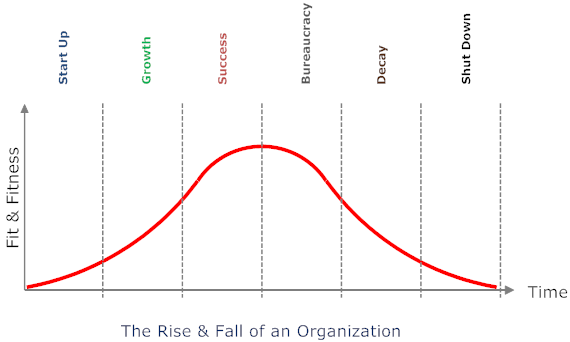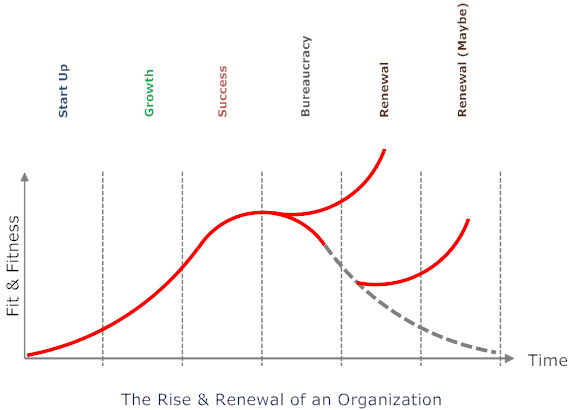Written by Fred Nickols
Most people agree that organizations have a life cycle; that, like people, they pass through some identifiable stages. Some see seven stages, some see as many as eleven. All agree that movement from one stage to the next must be managed. Failure to do so leads inevitably to the demise of the organization. In this article we'll look at a life cycle model that has six stages (see Figure 1).

Start Up
The first stage is Start Up, what some call "Launch" and others call "Venture." Here, the founder(s) and close associates set out to establish a business, to develop and market a product or service. There is little in the way of formality, procedures, documentation and status differentials. Improvisation is the order of the day. Energy levels are high and the goal is to get the business up and running.
Growth
If Start Up is successful, the next stage is Growth, which entails expansion and no small amount of chaos, especially if the growth is large and rapid. The Start Up stage can succeed with "fly by the seat of the pants" management; the Growth stage cannot. It is in this stage that the need arises for more formal procedures, more specialized jobs, organizational structures, reliable systems, and probably a different kind of employee, one more suited to the emerging, formalized management and organizational structure.
Success
Assuming the transition from Start Up to Growth is successful and Growth itself succeeds, the organization enters a period or stage of Success. Growth continues, markets or at least niches come to be dominated, more products are launched and lead their field, revenues and profits are impressive. Now there is much to lose and risk-aversiveness enters the scene. The entrepreneur is replaced by the steely-eyed executive focused on the bottom line. Enter now the notion that the organization has arrived; that it has standing in the world of business.
Fit & Fitness
What happens during these first three stages is hinted at by the vertical axis in Figure 1. It is labeled "Fit & Fitness." "Fit" refers to the alignment of the organization with its environment. There is a good fit between the organization, its products and services, and the needs and wants of its customers. The organization bests its competitors and is attractive to investors and lenders. It is seen as a desirable place to work. "Fitness" refers to the capabilities of the organization; its processes are efficient and its technologies are leading edge; its people are loyal, engaged and committed; its marketing prowess is as good or better than that of its competitors and it is creating demonstrable value for its stockholders. Making it through the first three stages is very much a matter of establishing a good fit with the environment and ensuring the fitness of the organizations processes, systems, policies, management and employees.
Bureaucracy
At the peak of its success, the organization enters a new stage: Bureaucracy. It has arrived; it knows best; it becomes an institution. Attention turns away from customers, competitors and the larger environment and focuses on internal matters. Risk-aversiveness grows more intense and energy goes into protecting turf, status and the status quo. People are hired on the basis of how well they fit in, not what they bring to the organization. Discussions seem more concerned with what is suitable and how the organization's image will be affected than with how to target and achieve important results. This stage marks the beginning of the long, slippery slope downward toward decay and the eventual demise or shut down of the organization.
Decay
Between Bureaucracy and Shut Down lies Decay. This stage is marked by the deterioration of the organization. It might be gradual and take a long time or it might be quite sudden and dramatic. Customers and even entire markets are lost. Operations stumble, products perform poorly and isolated plants and operations are shut down. Talent begins going out the door and continues on its way elsewhere. At this point the fit between the organization and its environment is questionable and the fitness of the organization is obviously impaired. Eventually, the deterioration of the organization is such that it can no longer survive and it enters the final stage: Shut Down.
Shut Down
Shut Down can literally take the form of shutting down all operations, of boarding up the windows and doors and abandoning all facilities. Or it can take the form of dismemberment, of breaking up the organization and spinning off or selling off its part pieces. It might take the form of bankruptcy, from which might emerge a shadow or shell of the former organization, but the organization that went from Start Up to Success is no more.
This cycle is not inevitable. For one thing, many organizations never get out of Start Up; others fail during Growth and some even collapse during Success. So, all along the way, at each stage, there is the possibility of failure; success is never guaranteed. And so the transitions to and through each stage must be managed. This is especially true of organizations that make it through Success and find themselves in the stages of Bureaucracy or Decay.
Renewal
The way off the slippery downward slope is via Renewal, a return to a focus on "Fit and Fitness" that marked the first three stages of the life cycle (see Figure 2). Organizations have two shots at Renewal. The first is when they realize they've become a Bureaucracy and that Decay and Shut Down lie ahead of them. The second is when Decay sets in and the organization faces a crisis of survival. (The ideal point for launching Renewal would be at the peak of their success but the odds of convincing people of the need for Renewal at that point are slim to none.)

As Figure 2 suggests, attempting Renewal during the Bureaucracy stage is more likely to succeed than when the organization has already slipped into Decay. Nevertheless, turnarounds can and do happen. The only time it is too late for Renewal is when the organization is in Shut Down. The goal of Renewal is to reestablish the Fit & Fitness of the organization, to realign it with its environment and to rejuvenate renew its capabilities.
So what do you do with this life-cycle view of organizations, this view of their rise and fall? Well, you can start by asking yourself some fundamental questions:
- Where is my organization in this life-cycle model?
- What stages have we already been through and how were those handled?
- What stages lie ahead of us and what are we doing to prepare ourselves for them?
- How good is our organization's "fit" with its environment?
- How "fit" are our organization's capabilities for the stage we're in and the stage we face?
You can also ask these questions of others in your organization and discuss their answers and yours. If your efforts are blunted, or pooh-poohed, or dismissed out of hand, it might be the case that your organization is somewhere out on that slippery slope down into Decay and Shut Down. In that case, you might want to start looking for a position with an organization that is making its way up the leading edge of the life cycle curve.
About the Author: My name is Fred Nickols. I am a writer, an independent consultant and a former executive. Visual aids of one kind or another have played a central role in my work for many years. My goals in writing for SmartDraw's Working Smarter blog are to: (1) provide you with some first-rate content you can't get anywhere else, (2) illustrate how important good visuals can be in communicating such content and (3) illustrate also the critical role visuals can play in solving the kinds of problems we encounter in the workplace.
SmartDraw makes diagramming easy